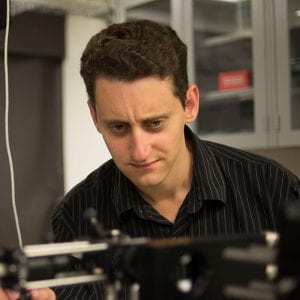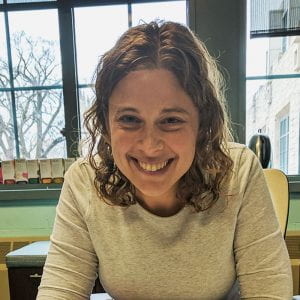What's Next for Quantum Science?
In August, Argonne National Laboratory in southwest suburban Lemont, Illinois, received $115 million in funding over five years from the U.S. Department of Energy (DOE) to create Q-NEXT, a transformative 100-person collaboration among universities, national laboratories and private companies that will work to advance the leading edge of quantum information science.

In designing this collaboration, Argonne has enlisted the expertise of three Northwestern faculty members from the Weinberg College of Arts and Sciences: physicist Nathaniel Stern and chemists Danna Freedman and Michael Wasielewski, all of whom are also affiliated of Northwestern’s cross-disciplinary quantum hub, the INQUIRE research institute. Freedman and Wasielewski serve on INQUIRE’s executive committee.
Wasielewski, who is also both executive director of the Institute for Sustainability and Energy (ISEN) and director of the Center for Molecular Quantum Transduction (CMQT) at Northwestern, describes Q-NEXT as an "all-encompassing" effort to harness the quantum properties of materials - those that rely on discrete energies or states of molecules or atoms - to gain "amazing advancements" in fields like computing or communications.
"Quantum computers can do complex computations in reasonable time that would take today's supercomputers the age of the universe to do," he says. "Q-NEXT is designed to look at all of these things as a unified whole. The endpoint, or the product, is designed to be a new technology based on quantum effects and materials. It could be a technology that takes us to the next level, like where microprocessors took us 40 years ago."
 Stern also cites the changes in society that computing has brought over the past half-century and predicts a similar impact for quantum going forward. "Quantum information processing is going to expand our ability to handle information as the information age continues to evolve," he says. One example: "The infrastructure that underlies banking and finance will be potentially enhanced by quantum information," Stern says.
Stern also cites the changes in society that computing has brought over the past half-century and predicts a similar impact for quantum going forward. "Quantum information processing is going to expand our ability to handle information as the information age continues to evolve," he says. One example: "The infrastructure that underlies banking and finance will be potentially enhanced by quantum information," Stern says.
While the media typically has focused on quantum computing, the idea of a quantum ecosystem has deep implications across fields both in practical and academic terms, Freedman says. "We're effectively transforming science from the bottom up. This is an unbelievably exciting time, with growth in every direction," she says. "We haven’t even mapped out the fundamental scientific questions that we’ll be able to address."
As a physicist, Stern studies the quantum properties of light, which he sees as a medium to transport quantum information. He envisions his role as fabricating novel quantum devices, such as computer chips, for use in quantum processing. "What's exciting about Q-NEXT and what it does for the quantum ecosystem is that it brings academic questions about quantum information into an environment where we’re trying to solve engineering problems." Those solutions are aimed at producing useful real-world applications, he says.
 Freedman believes quantum will come into play in sensing minute differences at the molecular or atomic level, which could help researchers probe anything from the magnetic properties of materials to analytes that would help to pinpoint disease detection. "In chemistry, we can harness the atomic precision in synthetic chemistry to create core units of the quantum information science system," she says. "We can append them with the functionality we want."
Freedman believes quantum will come into play in sensing minute differences at the molecular or atomic level, which could help researchers probe anything from the magnetic properties of materials to analytes that would help to pinpoint disease detection. "In chemistry, we can harness the atomic precision in synthetic chemistry to create core units of the quantum information science system," she says. "We can append them with the functionality we want."
Wasielewski says quantum research is also useful for understanding energy conversion processes, such as the use of sunlight to produce better photovoltaics, which is a significant science and technology goal of the DOE.
"The role of chemists and materials scientists in Q-NEXT is making new materials and studying their properties," he says. "Exquisite atom-by-atom control is desirable to create a new material that has the right functionality. That’s where the chemist comes into play - designing from scratch what you want, rather than just taking what nature gives you."
Northwestern brings deep and broad expertise in disciplines such as chemistry, physics, and materials science, but it also provides a uniquely collaborative culture in which team science thrives, Wasielewski says. "Northwestern didn’t have to invent a culture," he says. "We get together and do things as a team. The cooperation among students and faculty here is superb."
Wasielewski is excited by the likelihood of practical applications in the near term; he believes quantum science is now poised at the precipice where nanotechnology stood 10 or 15 years ago: as the next big thing.
"Nanotechnology today is embedded in a lot of things, and we will see quantum in a lot of the technology we take for granted in the next 10 to 15 years," he says. "It's going to come about quickly. Not only is the fundamental work progressing rapidly, but industry has put funds and effort into doing the engineering required to make it a practical technology."
"Science is cool," says Freedman. "When the electron was discovered more than 100 years ago, that happened out of random curiosity. Now, our entire society is built on the transfer of electrons through wires. The quantum nature of the universe is worth understanding, even if we can’t envision the scale of the application just yet."
By Ed Finkel